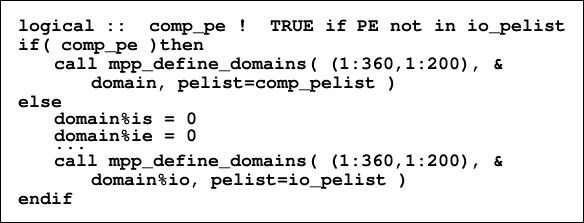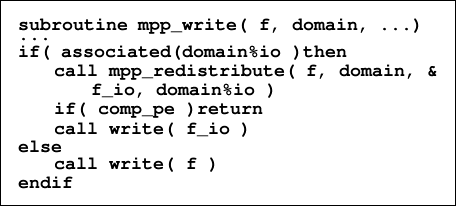PRINTSCRIPT;
print $script_style;
include "/var/www/html/core/partc";
$linkpage = <<< PRINTLINK
gfdl homepage >
people >
v. balaji's homepage >
this page
PRINTLINK;
print $linkpage;
// GFDL header
include "/var/www/html/core/partd";
$titlepage = <<< TITLEPAGE
IO Domains: Proposal to extend FMS data structures to support asynchronous parallel IO
TITLEPAGE;
print $titlepage;
// GFDL header
include_once( '/var/lib/php/counter.inc' );
error_reporting(E_ERROR);
require_once('../magpierss/rss_fetch.inc');
require_once('../magpierss/rss_utils.inc');
include "/var/www/html/core/parte";
$pagecontent = <<< ENDCONTENT
- Every component has an associated pelist. On mosaics, this is every tile
on every component.
- The pelist is broken into non-overlapping lists: a comp_pelist which
runs the model and an io_pelist, a set of PEs that only do I/O.
- When a domain decomposition is defined (call mpp_define_domains
. . . ) on pelist, it actually creates two domain decompositions, domain
and io_domain. (io_domain becomes part of the domain2D data
structure. domain is defined on pelist (which, recall, is the union
of comp_pelist and io_pelist) but the domain is actually spanned
by comp_pelist. The domains defined on the io_pelist have null
computational and data domains. (This is the tricky bit: will the data flow in
all our models work if some PEs go through it with null domains?)
Internally, we define a second decomposition of the same global domain, in
io_domain. Schematically, the code running on 16 PEs looks like:
 | (1) |
Within mpp_define_domains, this defines 2 decompositions:
 | (2) |
- The component executes on pelist: the PEs in io_pelist will skip all the
computational parts, since they have null domains. (What will happen if there’s an
mpp_sync?)
- When I/O occurs (call mpp_write(...,f,domain,...), domain is
checked to see if an io_domain has been defined; if so we redistribute the data
onto the io_domain. This will be a non-blocking call for the PEs on
comp_pelist. which can move on to do more computation. The PEs on
io_pelist do a blocked receive and then issue actual I/O calls. Schematically, the
code flow looks like Figure 1.
 | (3) |
This, in essence, is an asynchronous I/O package. Some PEs do computation and do
non-blocking sends of the data to I/O PEs. The I/O PEs flow through the computational
code without executing any loops, but block at every call to mpp_write, to receive data
and perform I/O.
All the code will be in mpp_io, mpp_domains and below. . . higher-level code,
including fms_io and diag_manager, and model code, remains untouched (except
for the domain setup).
 created by v. balaji (balaji
created by v. balaji (balaji princeton.edu) in emacs using Tex4HT.
princeton.edu) in emacs using Tex4HT.
ENDCONTENT;
print $pagecontent;
print "last modified: ". date( "d F Y", getlastmod() );
print "
this page visited: ".getCount(). " times ";
include "/var/www/html/core/partf";
include "/var/www/html/core/partg";





